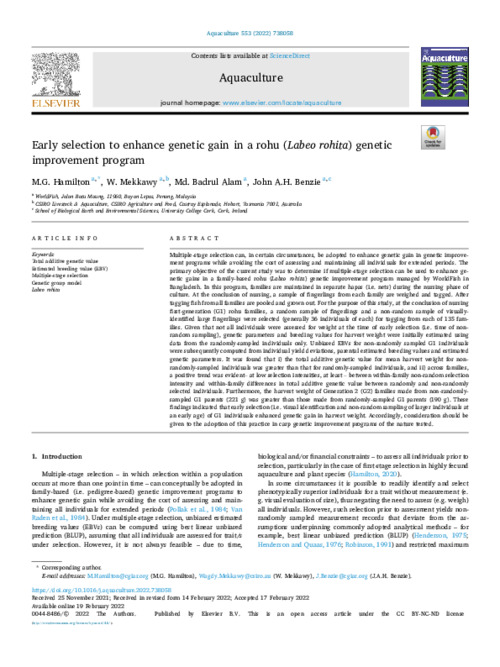Early selection to enhance genetic gain in a rohu (Labeo rohita) genetic improvement program

Multiple-stage selection can, in certain circumstances, be adopted to enhance genetic gain in genetic improvement programs while avoiding the cost of assessing and maintaining all individuals for extended periods. The primary objective of the current study was to determine if multiple-stage selection can be used to enhance genetic gains in a family-based rohu (Labeo rohita) genetic improvement program managed by WorldFish in Bangladesh. In this program, families are maintained in separate hapas (i.e. nets) during the nursing phase of culture. At the conclusion of nursing, a sample of fingerlings from each family are weighed and tagged. After tagging fish from all families are pooled and grown out. For the purpose of this study, at the conclusion of nursing first-generation (G1) rohu families, a random sample of fingerlings and a non-random sample of visually-identified large fingerlings were selected (generally 36 individuals of each) for tagging from each of 135 families. Given that not all individuals were assessed for weight at the time of early selection (i.e. time of non-random sampling), genetic parameters and breeding values for harvest weight were initially estimated using data from the randomly-sampled individuals only. Unbiased EBVs for non-randomly sampled G1 individuals were subsequently computed from individual yield deviations, parental estimated breeding values and estimated genetic parameters. It was found that i) the total additive genetic value for mean harvest weight for non-randomly-sampled individuals was greater than that for randomly-sampled individuals, and ii) across families, a positive trend was evident– at low selection intensities, at least – between within-family non-random selection intensity and within-family differences in total additive genetic value between randomly and non-randomly selected individuals. Furthermore, the harvest weight of Generation 2 (G2) families made from non-randomly-sampled G1 parents (221 g) was greater than those made from randomly-sampled G1 parents (190 g). These findings indicated that early selection (i.e. visual identification and non-random sampling of larger individuals at an early age) of G1 individuals enhanced genetic gain in harvest weight. Accordingly, consideration should be given to the adoption of this practice in carp genetic improvement programs of the nature tested.
Permalink
Date Available
Type
Publisher
Countries
ISSN
0044-8486
Copyright
CC-BY-NC-ND-4.0
Research Themes
Topics
Language